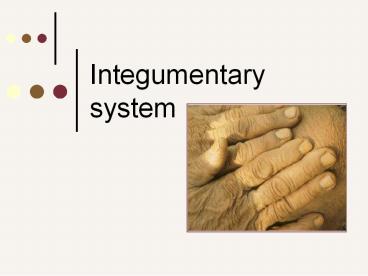Integumentary system PowerPoint PPT Presentation
1 / 34
Title: Integumentary system
1
Integumentary system
2
Parts
- Skin largest organ
- Sweat glands
- Oil glands
- Hair
- Nails
3
The skin (integument)
4
Structure of skin
- 3 layers
- Epidermis
- Dermis
- Subcutaneous tissue (or hypodermis)
5
(No Transcript)
6
(No Transcript)
7
Skin layers in detail
8
EPIDERMIS
9
characteristics
- Most superficial layer
- Keratinized stratified squamous epithelium
- Avascular
- 5 layers
10
Layers of epidermis
- Bottom layer firmly attached to dermis, constant
mitosis - More superficial layers flatten, fill with
keratin hard protein - Most superficial layer dead cells, thickest
We get a new epidermis every 30 days
11
DERMIS
12
characteristics
- Under epidermis
- Dense connective tissue
- Hide of animals
- Vascularized controls body temp.
- Many nerves
- 2 layers
- Dermal papillae raised ridges
13
Dermal papillae
- Create fingerprints due to sweat
- Genetically determined
- Create friction/gripping ability
14
(No Transcript)
15
(No Transcript)
16
HYPODERMIS
17
characteristics
- Deep to dermis
- Adipose tissue
- Anchors skin to organs underneath
18
FUNCTIONS OF SKIN
19
Functions
What functions can you already name?
- Keeps water in/out
- Insulates/cushions inner organs
- Sense of touch (touch, pressure, temperature,
pain)
20
DONT WRITE Adult skin weighs 10-11 pounds
- Protect against
- Entry of bacteria
- UV radiation (melanin protects the DNA of cells
from mutating)
21
- Regulates temperature
- Dilation of blood vessels ? lets heat out
- Sweat ? keeps you cool
22
SKIN COLOR
23
WHAT IMPACTS/DETERMINES SKIN COLOR?
24
- 1. Melanin
- yellow-brown-black
- varies in amount and kind
- Produced by bottom of epidermis
- Sun causes cells to produce more
- Protects cells nuclei (DNA) from UV radiation
25
- Carotene
- Found in foods, orange pigment
26
- 3. oxygen-rich hemoglobin
27
BURNS
28
causes
- Heat
- Electricity
- UV radiation
- Chemicals
29
Why they are dangerous
- Dehydration
- Rule of nines
- Infection
- Dead tissue yummy for bacteria/fungi
30
DONT WRITE
An adult who has been burned, the percent of the
body involved can be calculated as follows Head
9 Chest (front) 9 Abdomen (front) 9
Upper/mid/low back and buttocks 18 Each arm
9 Each palm 1 Groin 1 Each leg 18
total (front 9, back 9) As an example,
if both legs (18 x 2 36), the groin (1) and
the front chest and abdomen were burned, this
would involve 55 of the body.
31
Classification of burns(by severity)
- first-degree burns
- Damaged epidermis
- Red and swollen
- Heal in days
- Ex sunburn
32
- Second-degree burns
- Epidermis and upper dermis
- Blisters
- Regrowth possible
33
- Third degree burn
- Damage entire skin
- Appears gray/white, blackened
- Burn area not painful
- Regrowth not possible
- Skin grafts
- scars
34
(No Transcript)

